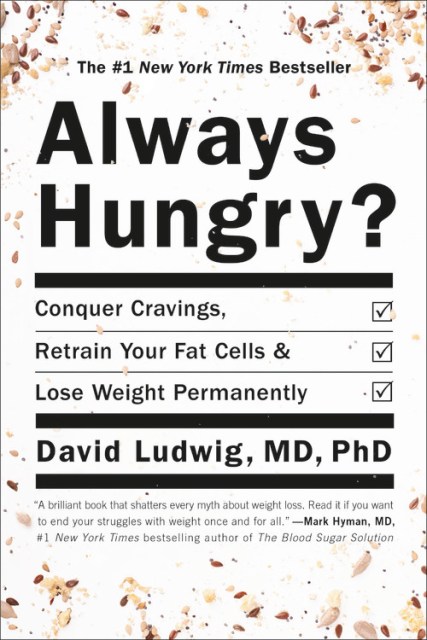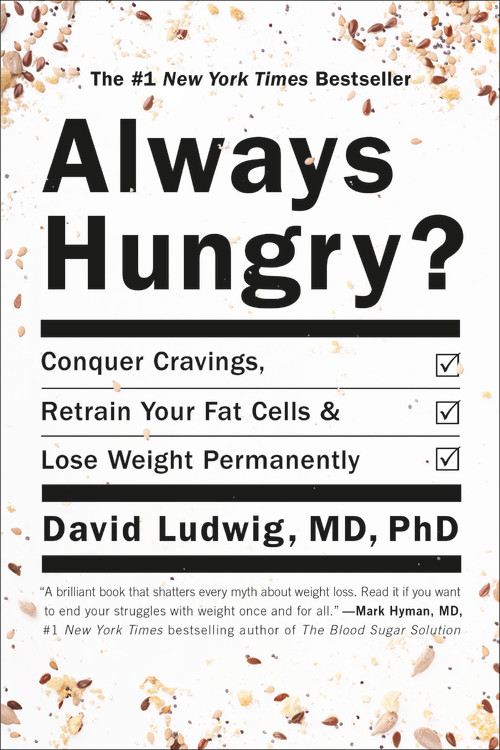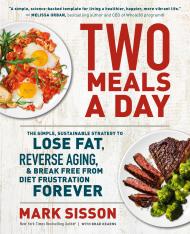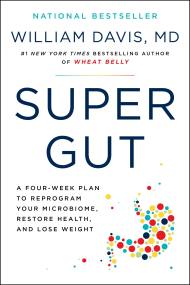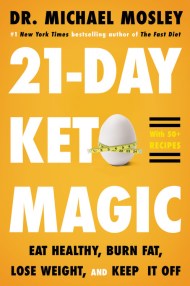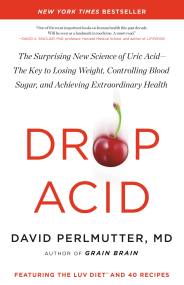Always Hungry?
Conquer Cravings, Retrain Your Fat Cells, and Lose Weight Permanently
Contributors
Read by Dawn Ludwig
Formats and Prices
Price
$18.99Price
$23.99 CADFormat
Format:
- Trade Paperback $18.99 $23.99 CAD
- ebook $11.99 $14.99 CAD
- Hardcover $40.00 $50.00 CAD
- Audiobook Download (Unabridged)
This item is a preorder. Your payment method will be charged immediately, and the product is expected to ship on or around December 18, 2018. This date is subject to change due to shipping delays beyond our control.
Also available from:
Leading Harvard Medical School expert and “obesity warrior” (Time magazine) Dr. David Ludwig rewrites the rules on weight loss, diet, and health in this guide to retraining your cells and reclaiming your health for life.
Forget everything you’ve been taught about dieting. In Always Hungry?, renowned endocrinologist Dr. David Ludwig explains why traditional diets don’t work and presents a radical new plan to help you lose weight without hunger, improve your health, and feel great.
For over two decades, Dr. Ludwig has been at the forefront of research into weight control. His groundbreaking studies show that overeating doesn’t make you fat; the process of getting fat makes you overeat. That’s because fat cells play a key role in determining how much weight you gain or lose. Low-fat diets work against you by triggering fat cells to hoard more calories for themselves, leaving too few for the rest of the body. This “hungry fat” sets off a dangerous chain reaction that leaves you feeling ravenous as your metabolism slows down. Cutting calories only makes the situation worse by creating a battle between mind and metabolism that we’re destined to lose. You gain more weight even as you struggle to eat less food.
Always Hungry? turns dieting on its head with a three-phase program that ignores calories and targets fat cells directly. The recipes and meal plan include luscious high-fat foods (like nuts and nut butters, full-fat dairy, avocados, and dark chocolate), savory proteins, and natural carbohydrates. The result? Fat cells release their excess calories, and you lose weight – and inches – without battling cravings and constant hunger. This is dieting without deprivation.
Forget calories. Forget cravings. Forget dieting. Always hungry? reveals a liberating new way to tame hunger and lose weight for good.
-
"Once in a generation a scientist comes along who tells a new story about why we are sick and how we can heal. Dr. David Ludwig is that scientist. Always Hungry? is a powerful book that breaks apart every myth about weight loss, and explains for the first time why we get fat and why we are always hungry. If you want to end once and for all your struggles with weight, then read this book, and follow its guidance." --Mark Hyman, MD, director, Cleveland Clinic Center for Functional Medicine, and #1 New York Times best-selling author of The Blood Sugar Solution
-
"David Ludwig is one of the very few voices of true authority in the world of obesity. This book goes to the heart of the underlying cause of weight gain--being constantly hungry. If you care about your health future, then this is the one book you should read and pay careful attention to." --Dr. Barry Sears, #1 New York Times bestselling author of The Zone
-
"Always Hungry? will cause a much needed seismic shift in the way we think about weight loss. Prepare to change your health for the better." --Andrew Weil, MD, founder and director of the Arizona Center for Integrative Medicine, University of Arizona
-
"Always Hungry? deftly explores the science underlying why we make our food choices. And this information, so well presented, is a game-changer. Dr. Ludwig's dietary plan lets you look upon food with passionate embrace as the fundamental key to changing your health destiny." --David Perlmutter, MD, New York Times bestselling author of Brain Maker
-
"Finally, an explanation for why so many people have failed in dieting, and a roadmap for how to improve metabolism, curb hunger, and lose weight successfully. Dr. Ludwig's book is not only instructive, it is life-transforming." --Francine Kaufman, MD, past president, American Diabetes Association and author of Diabesity
-
"Dr. Ludwig explains why throwing out our calorie-counters and paying more attention to the quality of our diets can result in a healthier weight, and to more enjoyment from eating at the same time. This is a must-read for anyone who has struggled to maintain a healthy weight." --Professor Walter Willett, Harvard T.H. Chan School of Public Health and New York Timesbestselling author of Eat, Drink, and Be Healthy
-
"Finally, after decades of portion control, counting calories, and low-fat diets, a weight loss book based on modern science. All calories are not created equal, and all diet books are not the same: Always Hungry? sets a new standard for successful, healthy weight loss." --Dariush Mozaffarian, MD DrPH dean, Tufts Friedman School of Nutrition Science & Policy
-
"Starving yourself and over-exercising makes you weak, not thin. Learn from a leading voice in nutrition how to strategically use food to permanently end cravings. You'll never worry about calories again." --Dave Asprey, New York Times bestselling author and founder of Bulletproof Coffee
-
"In Always Hungry?, world renowned endocrinologist and researcher David Ludwig explains in clear, accessible language what has made Americans so fat and what we can do to reverse the obesity epidemic for our ourselves, our children and our nation. This is a must-read!" --Arthur Agatston, MD, author of the New York Times bestseller The South Beach Diet
-
"David Ludwig's work is an inspiration. He clearly shows you can lose weight without being hungry by focusing on what you eat, not how much you eat. Read Always Hungry? if you want to lose weight without the struggle." --Louis Aronne, MD, past president of The Obesity Society and author of Change your Biology Diet
-
"This is NOT a diet book. Instead, it describes a way of eating that reprograms our fat cells to release excess fat for weight loss without hunger. Ludwig combines cutting-edge science and clinical experience into an achievable eating pattern that anyone could follow." --Janet King, PhD, executive director of the Children's Hospital Oakland Research Institute and chair of the 2005 USDA Dietary Guidelines Advisory Committee
-
"David Ludwig is a leading thinker on nutrition and body weight control, and is one of the few who can harness the best of scientific information to help people in their everyday lives. This book is sound, helpful, and breaks new ground." --Kelly D. Brownell, PhD, dean, Sanford School of Public Policy, Duke University
-
"Ludwig's book is cutting-edge medicine wrapped with big doses of dietary advice and gentle explanations for why our appetite button may be permanently switched ON. It doesn't get better than this." --Professor Jennie Brand-Miller, University of Sydney, and author of The Low GI Handbook
-
"Eating less and moving more is no longer the Holy Grail of weight reduction. Instead, nationally acclaimed obesity researcher Dr. David Ludwig is sending your fat cells to boot camp for retraining. Readers will reap the rewards of Dr. Ludwig's years of revolutionary research as he provides an easy, practical blueprint for achieving and sustaining an optimal, healthy body weight." --Pamela Peeke MD, MPH, FACP, FACS, Pew Foundation Scholar in nutrition and metabolism, assistant professor of medicine, University of Maryland, and New York Times bestselling author of The Hunger Fix
-
"Always Hungry? is a gem. It's scientifically accurate, easy to understand, beautifully written, and downright inspiring. If you want to stay healthy for the rest of your life, read this book and follow the instructions." --Christiane Northrup, MD, New York Times bestselling author of Goddesses Never Age: The Secret Prescription for Radiance, Vitality, and Wellbeing
-
"I would recommend Ludwig's book both for clinicians and for patients who are looking for better understanding and useful solutions." --Sean Lucan, M.D. in U.S. News Health
-
"Want a lower-carb approach? The glycemic index diet makes the list. The knock against it: It's hard to follow. If you're looking for an easier method to try this approach, well-known obesity researcher David Ludwig of Harvard Medical School has you covered." --NPR's The Salt
-
"Contains excellent advice."Huffington Post
-
"If you're going to buy a weight-loss book this year, make it this one."MindBodyGreen
- On Sale
- Dec 18, 2018
- Page Count
- 384 pages
- Publisher
- Grand Central Publishing
- ISBN-13
- 9781455533879
Newsletter Signup
By clicking ‘Sign Up,’ I acknowledge that I have read and agree to Hachette Book Group’s Privacy Policy and Terms of Use
